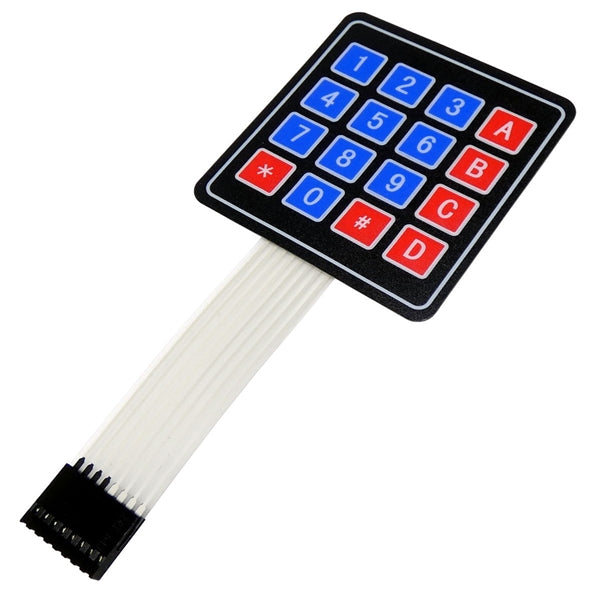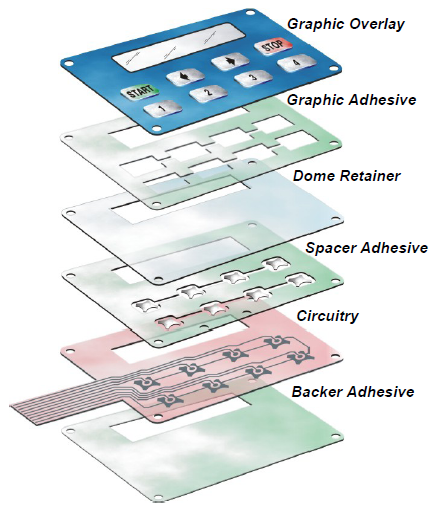Why Membrane Switches Are the Perfect Solution for Industrial Equipment
Why Membrane Switches Are the Perfect Solution for Industrial Equipment
Blog Article
Recognizing the Importance of Membrane Switches in Interface
Membrane buttons are important components in the layout of efficient customer interfaces, assisting in not only capability however additionally improving visual charm and user communication. Their unique attributes, such as resistance to environmental variables and customizable layouts, make them suitable for a varied selection of applications across numerous industries. As we check out the various advantages and future fads connected with Membrane technology, it ends up being clear that these buttons are more than simply parts; they represent a convergence of technology and practicality. The ramifications of this modern technology on user experience are worth checking out further.
What Are Membrane Buttons?

The spacer layer, which consists of sticky residential properties, permits the separation of the circuit layer from the overlay, guaranteeing that the switch continues to be in a non-activated state up until pressed. When pressure is related to the overlay, it presses the spacer layer, connecting the gap and finishing the circuit in the underlying layer. This design not just lowers the physical room required for traditional mechanical switches however also enhances the durability of the tool, as Membrane switches are usually resistant to dust, dampness, and other environmental variables.
Frequently found in applications varying from consumer electronics to clinical gadgets, Membrane switches are integral to modern-day technology, giving a straightforward and effective user interface that lines up with modern style needs.
Benefits of Membrane Switches
While countless switch modern technologies exist, Membrane Switches deal distinct benefits that make them particularly preferable in various applications. One of the key benefits of Membrane buttons is their compact style, which enables space-saving applications in tools where realty is restricted. Their slim profile not only boosts aesthetic charm yet likewise promotes lightweight building and construction.
Another considerable benefit is their resistance to environmental aspects. Membrane buttons are generally secured versus moisture, dust, and impurities, making them ideal for use in demanding settings, such as medical devices and industrial tools. This durability extends the life expectancy of the button, lowering maintenance costs and improving dependability.
In addition, Membrane switches can be personalized to satisfy certain design demands, integrating special graphics and shades that boost customer communication. Their responsive feedback options can also be tailored to provide a rewarding user experience. Additionally, Membrane switches are cost-effective, particularly in high-volume applications, as they can be produced efficiently.
Applications in Various Industries

In the customer electronic devices industry, Membrane switches are prevalent in tools such as microwaves, washing machines, and remotes. Their tactile responses and visual options boost individual experience while giving a smooth, modern appearance. Additionally, auto suppliers utilize Membrane switches in control panel controls and infomercial systems, where area is restricted, and customer involvement is vital.
Additionally, the commercial industry leverages Membrane buttons in control panels for equipment and equipment, permitting user-friendly operation in frequently rough atmospheres. Their resistance to chemicals and dampness guarantees long life and reliability in these applications. Generally, the adaptability of Membrane Switches adds considerably to their prevalent use, making them important in numerous technological domains.
Layout Considerations for Membrane Switches

When developing Membrane buttons, numerous vital considerations should be taken into consideration to make sure optimum capability and user experience. Firstly, the option of materials is important; picking sturdy, high-quality her latest blog substrates can enhance the switch's longevity and resistance to environmental elements such as wetness and temperature changes.
Secondly, the style of the graphic overlay should prioritize clarity and simplicity of usage. Symbols and message have to be understandable, and the design must facilitate intuitive interaction (membrane switches). Additionally, tactile responses is essential; integrating a tactile dome or various other systems can boost the individual experience by offering physical confirmation of activation
One more important aspect is the switch's electric efficiency. Designers must make certain that the conductive traces are effectively created to reduce resistance try these out and prevent signal interference. This entails examining the called for actuation force and making certain compatibility with the digital components they will certainly interface with.

Future Patterns in Membrane Modern Technology
As technology proceeds to advancement, Membrane switches are positioned to evolve dramatically, driven by advancements in materials and producing techniques. One arising pattern is the unification of sophisticated materials, such as versatile substrates and conductive inks, which improve resilience and lower the overall weight of Membrane buttons. These products not only boost the tactile response however likewise allow for the style of buttons that can endure harsher environmental problems.
Additionally, the integration of touch-sensitive modern technologies is changing typical Membrane Switches right into more interactive interface. Capacitive touch sensors embedded within Membrane button panels can provide a much more intuitive and receptive customer experience, aligning with the growing demand for smooth, modern-day layouts in customer electronic devices.
Additionally, developments in printing methods, such as digital and 3D printing, allow fast prototyping and personalization of Membrane switches. This versatility enables makers to react a lot more swiftly to market needs and customer choices.
Finally, sustainability is ending up being a considerable focus, with producers exploring green products and processes. As these patterns unfold, the future of Membrane modern technology assures boosted capability, visual charm, and environmental responsibility, strengthening their duty in sophisticated individual interfaces across numerous sectors.
Final Thought
Finally, Membrane Switches stand for an important component in the layout of customer interfaces, integrating functionality with visual adaptability. Web Site Their advantages, including durability and resistance to ecological elements, make them suitable for varied applications across various sectors. Moreover, thoughtful design factors to consider improve user communication and experience. As improvements in innovation continue, the advancement of Membrane buttons is expected to more fine-tune interface, driving technology and enhancing use in a progressively complex technical landscape.
Membrane buttons are essential parts in the style of reliable customer interfaces, helping with not just capability but additionally enhancing visual appeal and individual communication.Membrane Switches offer as an important part in different user interfaces, assisting in a smooth communication between users and electronic gadgets.While countless button technologies exist, Membrane Switches offer distinct advantages that make them especially preferable in numerous applications.In addition, Membrane buttons can be tailored to fulfill specific design requirements, incorporating distinct graphics and colors that enhance individual interaction.In final thought, Membrane Switches represent a vital component in the design of user interfaces, combining functionality with visual adaptability.
Report this page